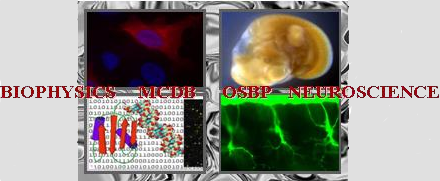Talk abstracts
Talk on Wednesday 09:30-09:45am submitted by Kiel Tietz
Pnrc2 promotes rapid clearance of oscillating transcripts through 3’UTR interactions
Kiel T. Tietz (Molecular, Cellular and Developmental Biology), Thomas L. Gallagher (Molecular Genetics, The Ohio State University, Columbus), Nicolas L. Derr (Molecular Genetics, The Ohio State University, Columbus), zachary T. Morrow (molecular Genetics, The Ohio State University, Columbus)
Abstract:
Vertebrate segmentation is regulated by the segmentation clock, a biological oscillator that controls embryonic segmentation (somitogenesis). This molecular oscillator generates cyclic gene expression in the tissue that generates somites, called the presomitic mesoderm (PSM), and has the same periodicity as somite formation. Molecular components of the clock include the hairy/Enhancer of split-related (her/Hes) family of transcriptional repressors, but additional transcripts also cycle. Maintenance of clock oscillations requires that transcriptional activation and repression, RNA turnover, translation, and protein degradation are all rapid (e.g., one cycle is 30 minutes in the zebrafish). We previously isolated a zebrafish segmentation clock mutant, tortuga, that have elevated cyclic transcript levels. We show that loss of proline-rich nuclear receptor coactivator protein Pnrc2 is responsible for cyclic transcript accumulation in tortuga deletion mutants by creating a new pnrc2 loss-of-function mutation and showing that cyclic transcript accumulation is identical in pnrc2 and tortuga mutants. pnrc2 mRNA is maternally provided and zygotically expressed, but Pnrc2 protein is not detected until just before somitogenesis begins. In maternal-zygotic pnrc2 mutants, cyclic transcripts perdure even longer, indicating that maternally-provided pnrc2 functions to promote cyclic transcript turnover. We show that the her1 3’UTR confers instability to otherwise stable transcripts in vivo in a Pnrc2-dependent manner, supporting our hypothesis that the 3’UTR of cyclic transcripts is critical for Pnrc2-mediated decay. To identify elements and factors required for rapid cyclic transcript turnover, we are defining minimal her1 3’UTR regions that are necessary and sufficient for rapid transcript decay. Our work will uncover post-transcriptional mechanisms regulating oscillation dynamics and cell fate during somitogenesis that may also be relevant for other biological patterns generated by oscillatory gene expression.
Keywords: her1, RNA Decay, 3UTR
